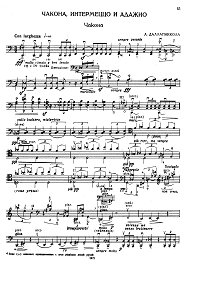Dallapiccola - Ciaccona, Intermezzo and Adagio for cello solo
Dallapiccola - Ciaccona, Intermezzo and Adagio for cello solo. You can download the PDF sheet music Dallapiccola - Ciaccona, Intermezzo and Adagio for cello solo on this page. The Ciaccona, Intermezzo e Adagio for solo cello was commissioned by Gaspar Cassado in 1945 while Dailapiccola was working on Il Prigioniero. The composer received advice on technical matters from Cassado as he worked on the piece. The chaconne has a surprisingly tonal thematic section which is followed by static music featuring an intricate set of variations. The theme reappears at the end. concluding on a major triad. The brief Intermezzo is structured in simple ternary form. The main section begins with the exposition of a tone series consisting of two sets of six pitches and is set in vivid contrast to the Trio, where effective use is made of natural harmonics. In the final Adagio, the sound of pure fifths in a manner reminiscent of Berg's Violin Concerto gradually takes on a sinister mood.
To download PDF, click the "Download PDF" button below the appropriate sheet music image.
To view the first page of Dallapiccola - Ciaccona, Intermezzo and Adagio for cello solo click the music sheet image. |
| PDF format sheet music |
|
|
|
Cello part: 10 pages. 569 K
|
|
 |
|
|
|
| Download PDF (14.99
€) |
|
|
Luigi Dallapiccola (1904 – 1975) was an Italian composer known for his lyrical twelve-tone compositions. It was Richard Wagner's music that inspired Dallapiccola to start composing in earnest, and Claude Debussy's that caused him to stop: hearing Der fliegende Holländer while exiled to Austria convinced the young man that composition was his calling, but after first hearing Debussy in 1921, at age 17, he stopped composing for three years in order to give this important influence time to sink in. Dallapiccola's works of the 1920s (the period of his adherence to fascism) have been withdrawn, with the instruction that they never be performed, though they still exist under controlled access for study.
His works widely use the serialism developed and embraced by his idols; he was, in fact, the first Italian to write in the method, and the primary proponent of it in Italy, and he developed serialist techniques to allow for a more lyrical, tonal style. Throughout the 1930s his style developed from a diatonic style with bursts of chromaticism to a consciously serialist outlook. He went from using twelve-tone rows for melodic material to structuring his works entirely serially. His disillusionment with Mussolini's regime effected a change in his style: after the Abyssinian campaign he claimed that his writing would no longer ever be light and carefree as it once was. While there are later exceptions, particularly the Piccolo concerto per Muriel Couvreux, this is largely the case.
Liriche Greche (1942–45), for solo voice with instruments, would be his first work composed entirely in this twelve-tone style, composed concurrently with his last original purely diatonic work, the ballet Marsia (1943). Most of his works would be songs for solo voice and instrumental accompaniment. His touch with instrumentation is noted for its impressionistic sensuality and soft textures, heavy on sustained notes by woodwinds and strings (particularly middle-range instruments, such as the clarinet and viola).
The politically charged Canti di prigionia for chorus and ensemble was the beginning of a loose triptych on the highly personal themes of imprisonment and injustice; the one-act opera Il prigioniero and the cantata Canti di liberazione completed the trilogy. Of these, Il prigioniero (1944–48) has become Dallapiccola's best-known work. It tells the chilling story of a political prisoner whose jailor, in an apparent gesture of fraternity, allows him to escape from his cell. At the moment of his freedom, however, he finds he has been the victim of a cruel practical joke as he runs straight into the arms of the Grand Inquisitor, who smilingly leads him off to the stake at which he is to be burned alive. The opera's pessimistic outlook reflects Dallapiccola's complete disillusionment with fascism (which he had naïvely supported when Mussolini first came to power) and the music contained therein is both beautifully realized and supremely disquieting.
His final opera Ulisse, with his own libretto after The Odyssey, was the culmination of his life's work. It was composed over 8 years, including and developing themes from his earlier works, and was his last large-scale composition. |
|